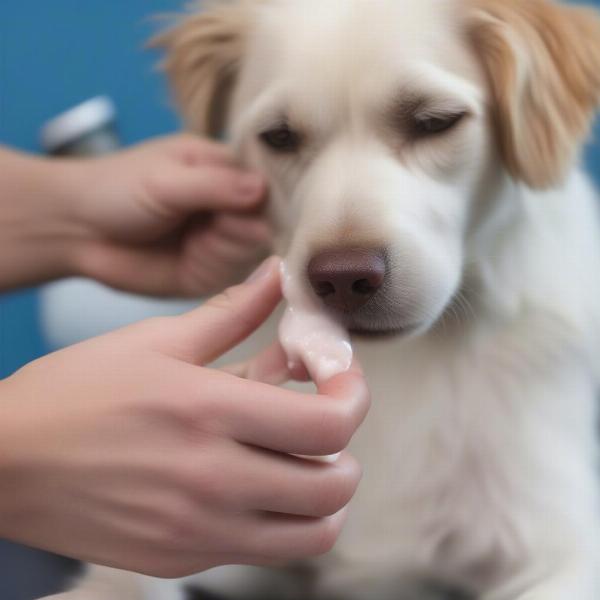Antiseptic creams play a crucial role in a dog’s first-aid kit. Knowing when and how to use these creams is essential for every dog owner. This guide explores the different types of antiseptic creams available for dogs, their uses, potential side effects, and when to seek veterinary advice. We’ll equip you with the knowledge to confidently care for your furry friend’s minor wounds and skin irritations.
Understanding the Need for Antiseptic Creams in Dogs
Just like humans, dogs can suffer from minor cuts, scrapes, burns, and skin infections. Antiseptic creams help prevent infection by killing bacteria and other harmful microorganisms on the wound surface. They also create a protective barrier to prevent further contamination and promote healing. Choosing the right antiseptic cream and using it correctly is vital for effective treatment.
 Applying antiseptic cream to a dog's paw
Applying antiseptic cream to a dog's paw
Choosing the Right Antiseptic Cream for Your Dog
Several antiseptic creams are safe for dogs, including those containing chlorhexidine, povidone-iodine, and silver sulfadiazine. Avoid using creams containing zinc oxide or other ingredients toxic to dogs if ingested. Consult your veterinarian for recommendations specific to your dog’s needs. They can advise on the most suitable product based on the type of wound and your dog’s medical history.
Chlorhexidine Gluconate
This antiseptic is effective against a broad range of bacteria and fungi. It’s available in various formulations, including solutions, sprays, and wipes.
Povidone-Iodine
Another common antiseptic, povidone-iodine, is known for its broad-spectrum antimicrobial activity. It’s available as a solution or scrub.
Silver Sulfadiazine
This cream is particularly useful for treating burns and preventing infections in deeper wounds.
Applying Antiseptic Cream to Your Dog
Before applying any cream, clean the wound gently with warm water and a mild pet-safe soap. Pat the area dry with a clean towel. Then, apply a thin layer of antiseptic cream to the affected area. Avoid applying too much, as this can hinder healing. Depending on the severity of the wound, you may need to apply the cream once or twice daily.
When to Consult a Veterinarian
While antiseptic creams are helpful for minor wounds, some situations require professional veterinary attention. If your dog’s wound is deep, bleeding profusely, or shows signs of infection (such as redness, swelling, pus, or a foul odor), seek immediate veterinary care. Also, contact your vet if the wound isn’t healing within a few days or if your dog experiences any adverse reactions to the cream.
Conclusion
Antiseptic creams are an essential part of any dog owner’s first-aid arsenal. Understanding how to choose and use these creams can help you manage your dog’s minor wounds effectively and prevent infections. However, always remember to consult your veterinarian for guidance on appropriate wound care and when to seek professional help. Keeping antiseptic cream on hand can provide peace of mind and allow you to respond quickly to minor injuries, ensuring your furry friend stays healthy and happy.
FAQ
- What is the best antiseptic cream for dogs? The best antiseptic cream depends on the specific wound. Consult your veterinarian for recommendations tailored to your dog’s needs.
- Can I use human antiseptic cream on my dog? No, some human antiseptic creams contain ingredients toxic to dogs. Only use products specifically formulated for pets.
- How often should I apply antiseptic cream to my dog’s wound? Follow your veterinarian’s instructions. Typically, application once or twice daily is sufficient.
- What should I do if my dog licks the antiseptic cream? While most antiseptic creams are not highly toxic in small amounts, it’s best to prevent your dog from licking the wound. Consult your veterinarian if excessive licking occurs.
- Can I use antiseptic cream on a dog bite wound? Dog bite wounds can be serious. Consult your veterinarian immediately for appropriate treatment.
- Are there any natural alternatives to antiseptic cream for dogs? Some natural remedies, such as honey and aloe vera, have antiseptic properties. However, always consult with your veterinarian before using any alternative treatments.
- How do I store antiseptic cream for dogs? Store antiseptic creams in a cool, dry place, away from direct sunlight and out of reach of children and pets.
ILM Dog is your trusted source for expert advice on all aspects of dog care, including breed selection, health and medical care, training and behavior, nutrition, grooming, exercise, puppy care, senior dog care, traveling with dogs, and product recommendations. We offer a comprehensive approach to dog ownership, empowering you to provide the best possible care for your furry friend. For any inquiries or to learn more about our services, contact us via email at [email protected] or call us at +44 20-3965-8624. ILM Dog is dedicated to helping you build a strong and lasting bond with your canine companion.